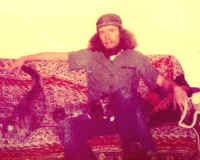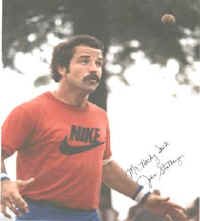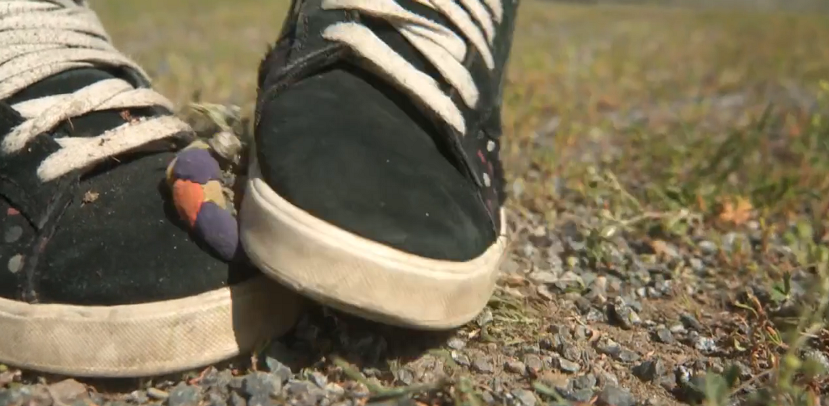
Footbag as we know it today is a young sport. Its roots can be traced to the year 1972, when Mike Marshall and John Stalberger from Oregon City in Oregon invented a kicking game using a homemade beanbag. Mike was using it to improve the flexibility of his previously injured knee. Since John had a background in football , baseball, and physical therapy, he decided to improve on the design and created a new type of kicking object. The very first Footbag was made from 2 pieces of fabric, similar to a baseball, and filled with plastic pellets that allowed for better control of the kicking trajectory. John soon began to figure out the best ways to kick the bag for this new game. Mike and John decided to try and bring the idea to the bigger audience, and so they named the game “Hacky Sack” and that very moment history of footbag was born.
The foundation for the sport was quickly created. Emphasis was put on proper kicking technique and equal training of both sides of the body was advised. Players also used their upper body and arms to keep their balance. The game was promoted at festivals and workshops and soon began to gain more and more popularity. One of it’s main appeals was the fact that it could be played by people of almost any age, and used both as a warming up technique, and as a fun, active and social pastime. With time, the players become more and more skilled, and soon began to compete against each other in different ways (consecutive kicking being one of the most popular).

Mike Marshall died tragically in 1975 at the age of 28 from a heart attack. John decided to continue the promotion of the brand, and started a Footbag manufacturing company under the name of “The National Hacky Sack Company”. It was the first company in the world to start organizing workshops and teaching the footbag concept in Oregon schools. The next big step was the formation of “The National Hacky Sack Association” (the NHSA) which was led by John Stalberger and Ted Huff. It was the first official governing body for the sport of Footbag. The NHSA was responsible for sanctioning and sponsoring different tournaments in the U.S., one of them being the “Footbag Nationals” which later on evolved to become World Footbag Championships, an annualy running event that has awarded the title of World Footbag Champion since 1980.
The NHSA ceased to exist in 1984, and was replaced by the World Footbag Association (WFA). Its founders were Bruce Guettich and Greg Cortopassi. The organization quickly grew into a touring team and a footbag products company. It also published a footbag magazine showcasing the current events inside the scene. In recognition of a need to further regulate the sport, the WFA formed the International Footbag Advisory Board (IFAB) to oversee the official Rules of Footbag Sports. This allowed the sport to become more consistent, and laid the foundations for further growth.
The next big event in the history of the sport was the creation of The World-Wide Footbag Foundation, Inc., which was incorporated as a California non-profit corporation in 1994 by Steve Goldberg, Julie Symons, Brent Welch, and David Butcher. That very same year, WWFF took the responsibility of hosting of the World Footbag Championships in San Francisco and Menlo Park, California. This marked a time of dynamic growth in the number of players around the U.S. In the following years, the World Footbag Championships began moving to a different cities, as since the creation of WWFF sanctioning process it was possible to decide which city would host the tournament using specified criteria. In 1994, thanks to the leader of the project, Steve Goldberg, the WWFF created and set up online the Footbag WorldWide Information Service. It became a platform for the exchange of information and media and allowed the sport to grow internationally.
The WWFF changed its name to the International Footbag Players’ Association, Inc. (IFPA) in the year 2000. The IFAB, which until that time had been the governing body responsible for the rules of the sport, reincorporated as a part of the IFPA and changed its name to the International Footbag Committee (IFC). The IFC has been the driving factor in the consolidation and improvement of the Official Rules of Footbag Sports, which can be found here.

The competition itself has evolved through the years. In the early years, it consisted mostly of Consecutive Kicks records attempts (both solo and doubles). Soon, more events began to emerge in the form of Footbag Net, a direct competition over the net with impressive aerial spikes, and Footbag Freestyle, a timed performance with emphasis on creative ways of controlling the bag without letting it drop. Those two branches proved to be the most popular, and to this day are the Footbag Disciplines most often represented at tournaments.
History of footbag is a history of a game invented by two passionate individuals, that has evolved into a international sport enjoyed by thousands of players. From this perspective, it can be said with certainty that the dream of Mike Marshall and John Stalberger became real.








